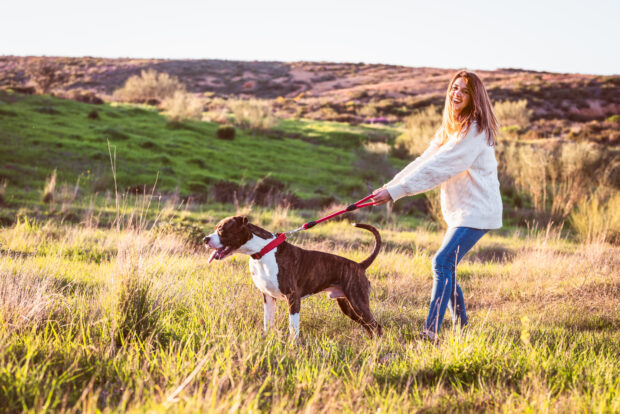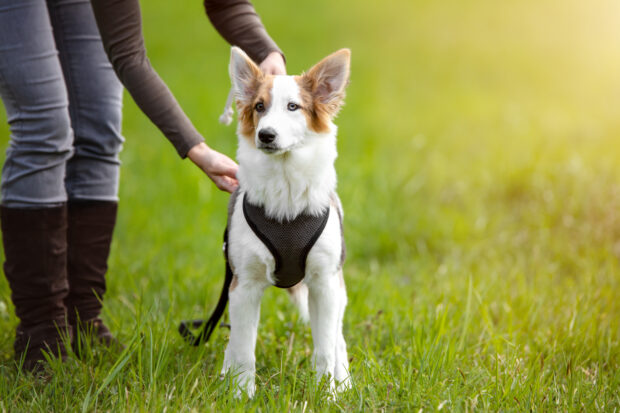So, which one should it be: harness or collar? Every dog owner has their preference but what it all boils down to is this: you should choose which type of restraint is most comfortable for your dog. Either of the two—collar or harness—is vital for keeping your dog safe and controlled whenever you go for walks. But what is better for your dog? Understanding the differences between the two might help you decide which is most comfortable, most effective, and safest for your furry kid.

1.Style
A dog collar is a strap that fits loosely around your pet’s neck. You can keep tags and licenses on the dog collar easily. Collars are more affordable than harnesses and are easy to find in pet stores. A harness, on the other hand, fits around your dog’s torso and chest. A harness comes in different styles and sizes. It also has back and front attachment types. Harnesses can also be more costly, depending on the manufacturer and the harness’s features.
2.Degree Of Control
Collars are easier for dogs to slip out of, especially they’re when frightened or panicked. Your dog will find it harder to slip out of a harness, especially if said harness fits the dog well. A harness also gives you better control not only for larger dogs but for smaller and energetic dogs, too, like the Italian Greyhound.
Italian Greyhounds, though they might seem like lapdogs, are sighthounds. Sometimes their nature might get the better of them and go chasing off some quick-moving prey. To better prepare for these instances, petsumer.com suggests these harnesses. Control is critical when you’re walking your dog in a busy street.
A collar, however, lets your dog move freely since straps don’t constrain his body. Long-haired dogs will prefer a collar because their hair won’t get caught in a harness’s straps. If your dog is prone to pull on his leash, a collar won’t be able to prevent this. However, a collar will discourage pulling because it can dig into the neck. On the other hand, harnesses give the dog more leeway in the neck area that could encourage him to pull.
But many dog trainers nowadays no longer favor training collars, like those prong collars that look more suited for hellhounds. Choke chains, shock collars, and slip leads are out of favor, too, because of the risk of injury to the dog.
3.Risk Of Injury
Small dogs that pull and tug are prone to injury wearing a collar, while dogs in a harness aren’t. The harness lessens the strain on your dog’s neck because the pressure is dispersed over a large area of his body. Furthermore, a collar can choke a dog if he suddenly lunged. It can put pressure on his neck and could cause throat, eyes, or ear problems. If your dog has a collar, make sure he is adequately trained and doesn’t pull or lunge, as these actions can cause injuries.
Your dog’s neck is very sensitive, even more sensitive than a human’s neck. Vital muscles, veins, as well as the spine, are located in the neck. Pressure applied to your dog’s neck causes tension. Harness use lessens the risk of your dog from hurting his neck and vital parts. The harness is also suited for dogs with respiratory problems and dogs whose eyes are prone to pop out due to pressure.
4.Ease Of Use
A collar is easier to use by far. Your furry kid can wear it at all times, or most of the time—some trainers advise owners to remove their dog’s collar during playtime. Moreover, it’s easier to put a collar on your dog’s neck. Collars are easier to remove, too. With a harness, you’d have to grapple with buckles and straps, plus a lot of cooperation from your dog.
5.Measuring The Right Fit
Getting the right fit for either of these restraints is also essential. Otherwise, having a badly-fitted harness or collar can cause problems for your dog. For a dog collar, measure the circumference of your dog’s neck. To get the right fit, put two fingers between the collar and your dog’s neck. If your two fingers don’t feel snug, the collar is loose, and your dog could easily slip out of the collar. And if you can’t fit two fingers in there, the collar is too tight.
For a dog harness, get your dog’s chest measurement. This time, your hand should fit under the harness and make sure it isn’t too tight or too loose. If you are an NFL or NBA player or similarly-sized, get somebody with a normal sized-hand to do your dog’s measurement.
Since collars and harnesses are adjustable, you can fiddle around with them to get the proper fit. Be sure to get a matching lead for your dog’s collar or harness. You’d want your furry kid to look cool so he can show off to his friends as you walk around the neighborhood. Along with a matching lead and collar or harness, make sure your dog also has other essential items.
Conclusion
The differences listed above are meant to give dog owners an idea of what’s best for their dog; collars and harnesses are made for different dog-handling styles. Remember, too, that it’s important that your dog always carry an identification tag.
Moreover, a collar or a harness won’t stop your dog from pulling and jumping. If you are concerned about effective training methods to stop your dog from doing either of these on your walks, you could research the subject. Trainers have different methods, but it won’t be difficult to find one that works for you and your dog.




